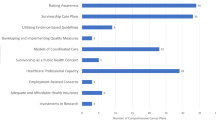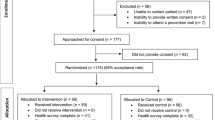Abstract
Introduction
Centers for Disease Control and Prevention’s (CDC) National Comprehensive Cancer Control Program (NCCCP) funds states, the District of Columbia, tribal organizations, territories, and jurisdictions across the USA develop and implement jurisdiction-specific comprehensive cancer control (CCC) plans. The objective of this study was to analyze NCCCP action plan data for incorporation and appropriateness of cancer survivorship-specific goals and objectives.
Methods
In August 2013, NCCCP action plans maintained within CDC’s Chronic Disease Management Information System (CDMIS) from years 2010 to 2013 were reviewed to assess the inclusion of cancer survivorship objectives. We used the CDMIS search engine to identify “survivorship” within each plan and calculated the proportion of programs that incorporate cancer survivorship-related content during the study period and in each individual year. Cancer survivorship objectives were then categorized by compatibility with nationally accepted, recommended strategies from the report A National Action Plan for Cancer Survivorship: Advancing Public Health Strategies (NAP).
Results
From 2010 to 2013, 94 % (n = 65) of NCCCP action plans contained survivorship content in at least 1 year during the time period and 38 % (n = 26) of all NCCCP action plans addressed cancer survivorship every year during the study period. Nearly 64 % (n = 44) of NCCCP action plans included cancer survivorship objectives recommended in NAP.
Conclusion
Nearly all NCCCP action plans addressed cancer survivorship from 2010 to 2013, and most programs implemented recommended cancer survivorship efforts during the time period.
Implications for Cancer Survivors
NCCCP grantees can improve cancer survivorship support by incorporating recommended efforts within each year of their plans.


Similar content being viewed by others
References
Hewitt M, Greenfield S, Stovall E. From cancer patient to cancer survivor: lost in transition. Committee on cancer survivorship: Improving care and quality of life. Washington (DC): National Academies Press; 2006.
Underwood, J. M., et al., Surveillance of demographic characteristics and health behaviors among adult cancer survivors—behavioral risk factor surveillance system, United States, 2009. 2012.
de Moor JS et al. Cancer survivors in the United States: prevalence across the survivorship trajectory and implications for care. Cancer Epidemiol Biomark Prev. 2013;22(4):561–70.
A national action plan for cancer survivorship: advancing public health strategies. Atlanta (GA): US Department of Health and Human Services, Centers for Disease Control and Prevention; 2004.
Sabatino SA et al. Receipt of cancer treatment summaries and follow-up instructions among adult cancer survivors: results from a national survey. J Cancer Surviv. 2013;7(1):32–43.
Dulko, D., et al. Barriers and facilitators to implementing cancer survivorship care plans. In Oncology Nursing Forum. 2013. Onc Nurs Society.
Fairley TL et al. Addressing cancer survivorship through public health: an update from the Centers for Disease Control and Prevention. J Women′s Health. 2009;18(10):1525–31.
National Comprehensive Cancer Control Program. Centers for disease control and prevention. http://www.cdc.gov/cancer/ncccp/about.htm. Accessed February 25, 2014
Major A, Stewart SL. Celebrating 10 years of the national comprehensive cancer control program, 1998 to 2008. Prev Chronic Dis. 2009;6(4):A133.
Stewart SL et al. Gynecologic cancer prevention and control in the National Comprehensive Cancer Control Program: progress, current activities, and future directions. J Women’s Health. 2013;22(8):651–7.
Neri, A., S. L. Stewart, and W. Angell, Peer reviewed: radon control activities for lung cancer prevention in National Comprehensive Cancer Control Program plans, 2005–2011. Preventing chronic disease, 2013. 10.
Dunne, K., et al., Peer reviewed: an update on tobacco control initiatives in comprehensive cancer control plans. Preventing Chronic Disease, 2013. 10.
White, D., Evidence-based interventions and screening recommendations for colorectal cancer in comprehensive cancer control plans: a content analysis.
Momin B, Richardson L. An analysis of content in comprehensive cancer control plans that address chronic hepatitis B and C virus infections as major risk factors for liver cancer. J Community Health. 2012;37(4):912–6.
Pollack LA et al. Cancer survivorship: a new challenge in comprehensive cancer control. Cancer Causes Control. 2005;16 Suppl 1:51–9.
Underwood JM et al. Persistent cigarette smoking and other tobacco use after a tobacco-related cancer diagnosis. J Cancer Surviv. 2012;6(3):333–44.
Rajotte EJ et al. Community-based exercise program effectiveness and safety for cancer survivors. J Cancer Surviv. 2012;6(2):219–28.
Huntsman DG, Gilks CB. Surgical staging of early stage epithelial ovarian cancer. Gynecol Oncol. 2011;122(2):460–1.
O′Malley CD et al. The implications of age and comorbidity on survival following epithelial ovarian cancer: summary and results from a Centers for Disease Control and Prevention study. J Women′s Health. 2012;21(9):887–94.
Hamilton AS et al. Regional, provider, and economic factors associated with the choice of active surveillance in the treatment of men with localized prostate cancer. JNCI Monographs. 2012;2012(45):213–20.
Trivers KF et al. Issues of ovarian cancer survivors in the USA: a literature review. Support Care Cancer. 2013;21(10):2889–98.
Roland KB et al. A literature review of the social and psychological needs of ovarian cancer survivors. Psychooncology. 2013;22(11):2408–18.
U.S. Cancer Statistics Working Group. United States Cancer Statistics: 1999–2007 Incidence and Mortality Web-based Report. Atlanta: U.S. Department of Health and Human Services, Centers for Disease Control and Prevention and National Cancer Institute; 2010. Available at: www.cdc.gov/uscs.
Martin, M. Y., et al., Meeting the information needs of lower income cancer survivors: results of a randomized control trial evaluating the American Cancer Society′s “I Can Cope”. Journal of health communication, 2014(ahead-of-print): p. 1–19.
Birken, S.A., et al., Following through: the consistency of survivorship care plan use in United States cancer programs. Journal of Cancer Education, 2014: p. 1–9.
Stricker CT, O′Brien M. Implementing the commission on cancer standards for survivorship care plans. Clin J Oncol Nurs. 2014;18:15–22.
Freeman HP, Rodriguez RL. History and principles of patient navigation. Cancer. 2011;117(S15):3537–40.
Dohan D, Schrag D. Using navigators to improve care of underserved patients. Cancer. 2005;104(4):848–55.
Percac-Lima S et al. A culturally tailored navigator program for colorectal cancer screening in a community health center: a randomized, controlled trial. J Gen Intern Med. 2009;24(2):211–7.
Wells KJ et al. Do community health worker interventions improve rates of screening mammography in the United States? A systematic review. Cancer Epidemiol Biomark Prev. 2011;20(8):1580–98.
Cancer, A.C.o.S.C.o., Cancer program standards 2012: ensuring patient-centered care. 2011: American College of Surgeons.
Acknowledgments
This work was supported by the Centers for Disease Control and Prevention’s Division of Cancer Prevention and Control. The findings and conclusions in this report are those of the authors and do not necessarily represent the official position of the Centers for Disease Control and Prevention.
Conflict of interest
All authors have read and approved the manuscript, and there are no financial disclosures and conflicts of interests.
Author information
Authors and Affiliations
Corresponding author
Rights and permissions
About this article
Cite this article
Underwood, J.M., Lakhani, N., Rohan, E. et al. An evaluation of cancer survivorship activities across national comprehensive cancer control programs. J Cancer Surviv 9, 554–559 (2015). https://doi.org/10.1007/s11764-015-0432-4
Received:
Accepted:
Published:
Issue Date:
DOI: https://doi.org/10.1007/s11764-015-0432-4




